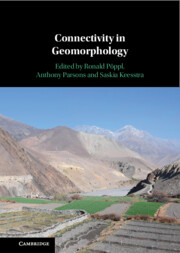Book contents
- Connectivity in Geomorphology
- Connectivity in Geomorphology
- Copyright page
- Contents
- Contributors
- Preface
- Acknowledgements
- Part I Introduction
- Part II Connectivity in Process Domains
- 3 Hillslope Processes
- 4 Fluvial Processes
- 5 Aeolian Processes
- 6 Glacial Processes
- 7 Periglacial Processes
- 8 Coastal and Deltaic Environments
- Part III Quantifying Connectivity in Geomorphology
- Part IV Managing Connectivity
- Index
- References
7 - Periglacial Processes
from Part II - Connectivity in Process Domains
Published online by Cambridge University Press: 10 April 2025
- Connectivity in Geomorphology
- Connectivity in Geomorphology
- Copyright page
- Contents
- Contributors
- Preface
- Acknowledgements
- Part I Introduction
- Part II Connectivity in Process Domains
- 3 Hillslope Processes
- 4 Fluvial Processes
- 5 Aeolian Processes
- 6 Glacial Processes
- 7 Periglacial Processes
- 8 Coastal and Deltaic Environments
- Part III Quantifying Connectivity in Geomorphology
- Part IV Managing Connectivity
- Index
- References
Summary
Periglacial regions and processes are particularly affected by contemporary climate change. These changes modify sediment connectivity and flux significantly. Connectivity is dynamic, evolving in response to the sediment transport processes it itself induces; and connection and disconnection have to be viewed as relative and multi-variate concepts. For most of the time, a landscape is functionally disconnected; sediment does not move. When it does move, at more connected locations it is more likely to move further downstream. However, because such sediment flux (i.e., functional connectivity) may cause landscape changes that in turn change connection, this static structural representations of connectivity also need to be considered as non-stationary. We illustrate these points using examples from the Arolla and Ferpecle-Mont Miné Valleys, located in the Val d’Hérens of Canton Valais, in Switzerland. These examples: (1) illustrate the spatial variability of the functional connectivity; (2) show how structural connectivity interacts with the processes that drive sediment flux; and (3) demonstrate the ways in which sediment flux can lead to evolution of structural connectivity.
Keywords
- Type
- Chapter
- Information
- Connectivity in Geomorphology , pp. 126 - 161Publisher: Cambridge University PressPrint publication year: 2025

